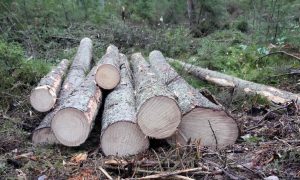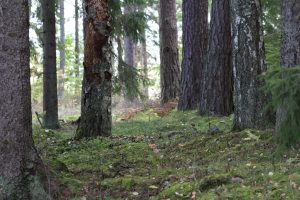There are lots of discussions going on, also here at NordicWoodJournal.com, about carbon storage. About how well a managed forest works as carbon storage. Some says that the forest owners should be paid for it, maybe even get more than if they cut it. Some are already being paid, but many claims that there is more to get. But … What about the biodiversity and the certifications? Can the forest supply us with both biodiversity and carbon storage? Let’s have a look at the situation.
Are we actually seeing a green war coming up?
On one hand we have the certifiers, like FSC (Forestry Stewardship Council), PEFC (Program for the Endorsement of Forest Certification schemes), ATFS (American Tree Farm System) and others. They (FSC and PEFC here in Sweden) say that 10 % of the certified forest land must work for biodiversity. This means that it should contain species that are not common in the rest of the forest and dead wood at all stages. Why? Because this type of environment has become rare (because of forestry), which have led to that species that need this environment also are rare, in some cases even red listed (= almost extinct).
On the other hand, we have the carbon storage people, who wants us to have well-managed forests that are optimal managed to catch and store as much carbon as possible. In a carbon storage forest, there is no room for free development and dead wood. This forest should be dense, vital and growing. The more it grows (and stays alive) the more carbon it can hold.
Both sides claim that their idea is in the best interest of the environment.
Photo: Fredrik Reuter
A leaking storage
Dead trees, that have been dead for more than one year, shall not be removed from the forest according to FSC (in Sweden). All this dead wood should be left to rot and disappear. Also fresh dead wood should be created according to FCS Sweden. This is normally done by making 3 – 4 meters high stumps of fresh trees, at least 3 per hectare. Those should also be left to decay and eventually disappear. In addition to this, 10 trees per hectare should be left for free development – forever. Every stage of those processes hosts special species of flora and fauna which helps to create, maintain, and restore biodiversity.
But dead wood that is rotting leaks carbon. Trees that stop growing binds less carbon, eventually dies and starts rotting, and leaking. Now, when we hear that we should use the forest as carbon storage for environmental reasons. Who wants a storage that leaks?!
Old trees die slow
It should be mentioned that old and thick dead trees that are left in the forest, leaks carbon very slow. So that kind of dead wood is perhaps not a big problem? Here in Sweden however, old thick trees are rare and should be kept alive as far as possible. That means that most of the dead wood that is left in the forest, is young and leaks carbon comparably fast.
Forest companies vs. forest owners
The forest companies of course want to see well-managed forests that produce good raw material for their industries. If the forest also can act as carbon storage, they will find themselves in a win-win situation.
A well-managed forest that is thinned to a number of stems per hectare that corresponds to the capacity of the soil (the site fertility) can store a maximum amount of carbon. When the forest stops growing, it binds less carbon and should be cut down and replaced by a new and fresh carbon binding forest. Apart from the certification requirements, this sounds like a good cycle that both forest owners and forest industry could live with. Or …?
The problem (here in Sweden and I guess in many other places) is that the forest industry wants wood – now! Especially the pulp and paper industry. They don´t want to wait until the forest’s natural cycle is ready. They thin very hard and they make clear cuts very early. In some cases, they thin much too hard and five to ten years later they tell the forest owner that: “This stand is too sparse. You have to clear-cut and reforest it.” It may seem exaggerated, but it happens.
What should “normal Joe” do?
The environment is important. I think everyone agrees with that. Most private forest owners, “Joes”, want to make good for both themselves, coming generations, the forest, and for the environment. But how? The demands come from everywhere and they are contradictory.
The forest companies demand that you are certified if they should buy your wood. The public demands that you are both certified and contributes to carbon storage and biodiversity as much as possible. The certifiers want you to leave 10 % of your forest for biodiversity development and leave all dead trees both standing and lying + some living trees. In addition to that the forest companies want to take out more wood than they should from your forest, and they attract you with money – now – which can be good – now.
But your children may want that some forest is left for them to cut, and to their children perhaps. Not to mention that we all may want wood for our houses, furnishing and furniture, toilet paper, and many other products that you can make from the great sustainable raw material that you get from the forest, also in the future.
Wouldn´t it be easier if all the environmental stuff came together in one regulation? For the forest owner it certainly would.
Photo: Per Jonsson
Who said life is easy?
You may have noticed, dear reader, that to give any advice in this to “normal Joe” is not so easy. There are services offered, where the common citizen can “plant” a tree for carbon storage by paying for it. Companies who offer this service then guarantee that unused field areas are forested, or that forests are fertilized to grow faster, or forest owners are getting paid to not cut their forest within a certain time frame and then store more carbon. Some say, this could be a way for small forest owners to make a buck or two by just doing what they were planning to do anyway – planting, fertilizing, or avoid clear-cutting for another decade or two.
My advice to Joe
Quite often forests have been in the family for generations. That means that the owners know how the forest reacts to different actions. My advice to this kind of forest owners is: Keep doing what you have been doing for generations. Areas that are difficult to reach due to terrain can be left without any action, for “free development” to make the environmentalists and certifiers happy. Dead and half rotten wood has no big value anyway so there is no point in bringing it out of the forest, at least not all of it.
If you are a new forest owner, it could be more difficult to know what to do. But there are advisers that you can ask, e.g., forest authorities. Many wood buyers are also giving advice to forest owners but here you should beware. As they are wood buyers the risk that their advice will be “cut-cut-cut” is big. As often in life, it may be best to use more than one adviser, a second and maybe a third opinion.
As for the possibilities of making money from carbon storage – check it out, but be very careful with what you sign.













